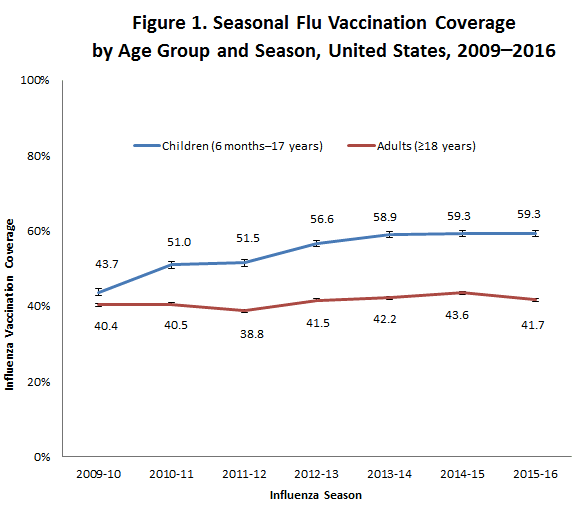It’s time to get your flu shot. Does that scare you?
The vaccine can keep you from getting influenza, but on the off-chance that you end up with the flu anyway, it can lessen its severity. And the shots are free for anyone with health insurance, thanks to the Affordable Care Act, and they’re available at doctors’ offices, clinics, pharmacies and even many schools and businesses.
However, flu vaccination rates have plateaued. Last season, only 43.3 percent of adults got the vaccine and only 59 percent of children. Among health care workers, only 78.6 percent got shots, similar to the 2015 to 2016 season’s 79 percent rate.
Public health officials at the National Foundation for Infectious Diseases’ annual flu news conference were at a loss to explain the stagnant rate.
But Patsy Stinchfield, senior director of infection prevention and control at Children’s Minnesota, had an idea: Nobody likes shots.
“People don’t like needles,” she said at Thursday’s conference. “And health care professionals actually have needle phobia just like the general population does.”

It’s safe to guess that most people don’t enjoy getting jabbed. But for a small minority of the population, it can grow into trypanophobia, or fear of needles, when the aversion to injections is so severe it produces a physical response, even fainting. Researchers estimate it affects 3 percent to 10 percent of the population.
Sometimes the phobia is so intense that it prevents a person from getting much-needed medical care. In an article for the British Journal of Anaesthesia, clinical psychologist Kate Jenkins writes of three patients she worked with to overcome needle phobia: a 24-year-old man whose fear was so extreme he refused to have chemotherapy to treat Hodgkin’s lymphoma, a pregnant woman who refused blood tests and a woman who had avoided medical care for so long she ended up with a 9-pound breast tumor.
Addressing needle fear is the driving force behind efforts to research other methods of delivering vaccines, including patches and sprays. But until a reliable alternative for flu vaccine hits the market, people are going to have to rely on psychological coping strategies to get through their doctor’s visit.
Jenkins writes that breathing exercises, relaxation strategies and controlled exposure to the thing they fear most are good ways to help people with milder needle phobias. But those who usually faint may need a more intense course of therapy.
Stinchfield’s advice? Breathe through the mouth, let your arm hang limp like a “spaghetti noodle” and then “imagine your favorite place in the whole wide world.”
Because needle phobia is so common, and because there are so many ways to approach the problem, we asked HuffPost readers what helped them get over their fear of needles. Here are four tips from readers that mirror doctors’ suggestions to dull pain, practice mindfulness or engage in immersive therapy.
1. Numb your skin with ice
After having to receive and give myself a shot every day for 34 weeks and twice a day for four weeks, I’ve learned that if you take a deep breath and count to three, I can handle it. Numbing the skin with an ice cube helps too. Can’t even feel it. ― Morgan A. Flannery
2. Listen to your favorite music
I have them lay me down, I don’t look, I relax because tensing makes it worse, and I usually have my favorite music in my headphones. I have had a lot of needles in the last two years (chemo, iron infusions, high risk pregnancy, etc.), and that combination has helped me a lot. Lastly I’m a hard stick and letting the staff know ahead of time is beneficial! Don’t let anyone dig around for a vein ― have them find a phlebotomist who is good at sticking!!! ― Julie Conant Wallace
3. Eat a snack before and after
I’m a fainter. I’ve started eating something, at least a granola bar, before AND after shots. I have to make a conscious effort to breathe in and out and to not hold my breath during the injection. I’ve also started telling the people drawing my blood or giving me shots that I’m a bleeder and I faint. It makes them be extra careful with me even if it’s been over a year since my last fainting spell. 💁🏼 ― Taylor Stoner
4. Face your fear head-on
Got over my fear of them in College when my friends made me type my blood for biology class, donate blood at the Red Cross, get my ears pierced and get my vaccinations all updated (had not been done since I was in grade school). This was all accomplished in the space of 4 hours! I used to break out in hives and get hysterical if the doctor even mentioned using a needle on me. Now I could care less. ― Nancy Foulke
Of course, there’s also the question of why some children grow up to develop extreme aversions to needles in the first place. A few studies suggest there are some risk factors, and they include parents’ anxiety about needles, painful past experiences with injections and a high number of same-day injections from ages 4 to 6.
It’s worth it to get over the phobia to get that flu shot each year, though. It’s especially important for people with chronic conditions including diabetes, lung disease and heart disease; those who are more susceptible to the illness; and people who are in frequent contact with others who are too young or medically compromised to be vaccinated.
And despite the myths, the vaccine doesn’t cause the flu, but it can come with some mild side effects, including fever, nausea and soreness at the injection site.
So really, it’s nothing to fear.